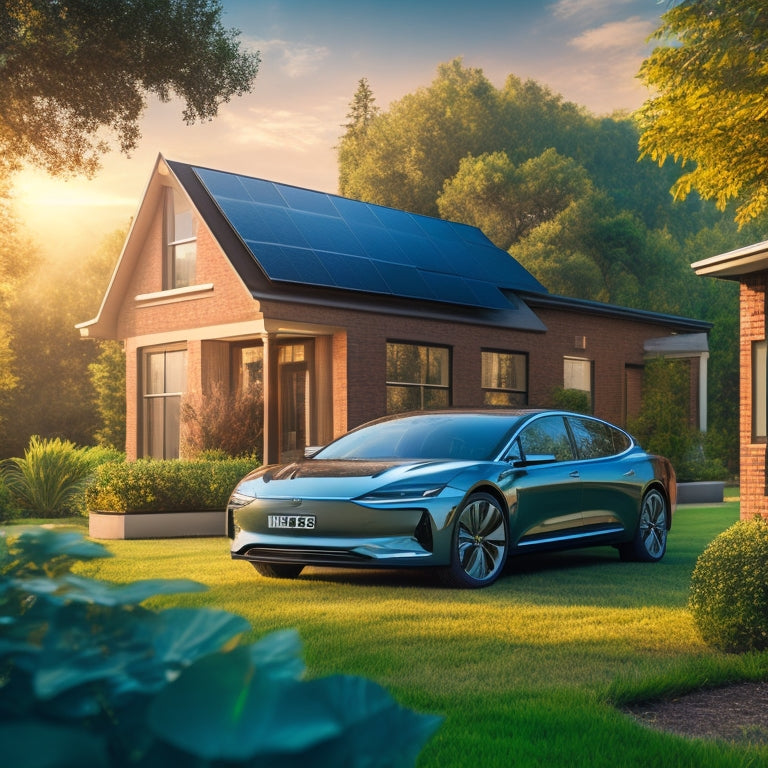
Maintain EV Charging With Proactive Panel Care
Share
To maintain peak EV charging with proactive panel care, you should schedule regular panel inspections every 6-12 months to identify potential issues early. Monitor panel temperature fluctuations and address damaged or loose connections, corrosion, and debris accumulation promptly. Implement cleaning strategies for peak output and minimize dust accumulation. By prioritizing proactive care, you'll minimize downtime, electrical hazards, and maximize energy harvest, reducing your carbon footprint. As you take proactive measures, discover more strategies to optimize your EV charging experience and stay ahead of potential issues.
Key Takeaways
• Schedule regular panel inspections every 6-12 months to identify potential issues early and maintain peak performance and safety.
• Address damaged or loose connections, corrosion, and debris accumulation promptly to prevent compromised EV charging capabilities.
• Implement cleaning strategies for optimal output and minimize dust accumulation to ensure efficient energy harvest.
• Monitor panel temperature fluctuations closely using thermal imaging tools and heat mapping to detect issues and prevent overheating.
• Prioritize predictive maintenance strategies to minimize downtime and electrical hazards, and maximize energy harvest to reduce carbon footprint.
Scheduling Regular Panel Inspections
To guarantee peak performance and safety, you should schedule regular inspections of your EV charging panel every 6-12 months, depending on usage and environmental factors.
This routine check-up ensures your panel operates at its best levels, minimizing downtime and reducing the risk of electrical hazards. By inspecting your panel regularly, you can identify and address potential issues before they escalate, maintaining excellent panel performance.
The inspection frequency will vary depending on your specific situation, but as a general rule, you should inspect your panel every 6-12 months. By doing so, you'll be in control of your EV charging experience, ensuring a safe, efficient, and reliable charging process.
Identifying Common Solar Panel Issues
Regular inspections can uncover common solar panel issues. These include damaged or loose connections, corrosion, and debris accumulation. Such issues can greatly impair your EV charging panel's performance and safety. Identifying these issues promptly is crucial to prevent panel failure, energy loss, and compromised EV charging capabilities.
During inspections, it is important to look for signs of wear and tear. This includes cracks, fading, or discoloration. Check connections for looseness or corrosion, and inspect the panel's surface for debris buildup. By catching these issues early, you can take corrective action to prevent more severe problems from developing.
Stay vigilant and proactive to guarantee your EV charging panel operates at peak efficiency and safety.
Cleaning Strategies for Optimal Output
You can greatly enhance your EV charging panel's efficiency by implementing a regular cleaning schedule, as a buildup of dirt, dust, and debris can reduce its energy output by up to 25%.
To minimize dust mitigation, use a soft-bristled brush or a specialized solar panel cleaning tool to gently sweep away loose particles. For more thorough cleaning, use a mild soap and water solution, taking care to conserve water and avoid using high-pressure washes that can damage the panels.
A bi-weekly cleaning schedule can help maintain peak output and reduce energy losses. By prioritizing regular cleaning, you'll make sure your EV charging panel operates at its best, maximizing your energy harvest and reducing your carbon footprint.
Panel Temperature Monitoring Essentials
High temperatures can greatly diminish your EV charging panel's efficiency, and monitoring its temperature is essential to prevent overheating, which can lead to permanent damage. You need to keep a close eye on your panel's temperature to guarantee peak performance. Thermal imaging and heat mapping are essential tools in monitoring temperature fluctuations. These technologies help identify hotspots and prevent overheating.
| Temperature Ranges | Actions |
|---|---|
| 25°C - 40°C | Normal Operating Range |
| 40°C - 60°C | Monitor closely for potential overheating |
| 60°C - 80°C | Take corrective action to reduce temperature |
| Above 80°C | Immediate shutdown to prevent damage |
Effective Inverter Maintenance Tips
To guarantee your EV charging station operates efficiently, you'll want to prioritize effective inverter maintenance. By following a few key tips, you can prevent downtime and keep your charging station running smoothly.
Regular Inverter Inspections
Regularly inspecting your EV charging station's inverter guarantees peak performance, efficiency, and safety, as it helps identify potential issues before they cause downtime or equipment failure. By doing so, you'll confirm that your inverter operates within the manufacturer's specifications, maintaining its warranty and optimizing its software. This proactive approach enables you to:
| Inspection Focus | Frequency |
| Inverter software updates | Quarterly |
| Electrical connections and cables | Monthly |
| Cooling system and air filters | Bi-Monthly |
Staying on top of these inspections will help you identify and address potential issues before they escalate, ensuring your EV charging station operates at its best.
Clean Inverter Components
Dust and debris accumulation on inverter components can greatly impede your EV charging station's performance, so you should clean them regularly to guarantee peak operation.
When you neglect cleaning, dust accumulation can lead to corrosion risks, compromising the reliability of your charging station. To prevent this, use compressed air or a soft-bristled brush to gently remove dust and debris from components.
Be cautious not to touch electrical components, as the oils from your skin can attract dust and exacerbate the issue.
Schedule Downtime Wisely
You'll minimize disruptions to your EV charging operations by strategically scheduling downtime for inverter maintenance, ensuring that your station remains efficient and reliable. By doing so, you'll reduce the likelihood of unexpected outages and optimize your energy output. Consider implementing predictive maintenance strategies, such as energy forecasting, to identify potential issues before they arise.
| Maintenance Task | Recommended Frequency |
|---|---|
| Inverter software updates | Quarterly |
| Thermal imaging inspections | Semiannually |
| Electrical component replacements | Annually |
Debris Removal and Panel Protection
Debris accumulation on EV charging panels can lead to overheating, electrical failures, and even fires, making regular cleaning a critical maintenance task. You should prioritize removing dirt, dust, and other debris from your panels regularly.
Use a soft-bristled brush or a microfiber cloth to gently sweep away loose particles. For more stubborn debris, you can use a mild detergent and water solution. Don't forget to inspect and clean your panel shields and weather seals, ensuring they're free from obstructions.
Visual Inspection Best Practices
Regularly inspecting your EV charging station's electrical components and cables helps identify potential issues before they become major problems. You'll want to establish a routine inspection frequency to catch any potential issues early on.
During each inspection, focus on quality checkpoints such as connectors, wires, and terminals. Check for signs of wear, corrosion, or damage. Make sure all connections are secure and tightened properly. Look for any signs of overheating, such as burn marks or melted components.
Performance Monitoring and Analysis
By tracking your EV charging station's performance metrics, you can identify trends and anomalies that may indicate underlying issues, allowing you to take corrective action before they impact your operations.
Through data visualization, you can quickly analyze key performance indicators, such as charging speeds, energy consumption, and system uptime. This enables you to pinpoint areas for improvement and optimize your charging station's performance.
Additionally, energy forecasting allows you to predict energy demand and adjust your charging strategy accordingly. By staying on top of your station's performance, you can guarantee reliable and efficient charging, reducing downtime and improving the overall user experience.
With proactive monitoring and analysis, you'll be well-equipped to maintain a high-performing EV charging station.
Preventing Rodent Infestation Damage
It's important to take proactive measures to prevent infestation of rodents that can wreak havoc on your EV charging station's electrical components, causing costly damage and downtime.
As you maintain your EV charging station, you should prioritize rodent-proofing to avoid unwanted surprises. Install rodent repellents, such as ultrasonic devices or natural deterrents, to discourage rodents from nesting near your equipment.
Additionally, practice wildlife exclusion by sealing any entry points, such as holes or gaps, around your charging station. This will prevent rodents from accessing your electrical components.
Adapting to Seasonal Energy Demands
You'll need to adjust your EV charging station's energy output to accommodate seasonal fluctuations in energy demands. As winter approaches, you'll likely see an increase in energy consumption due to colder temperatures and shorter days. Conversely, summer months typically bring decreased energy demands.
By leveraging advanced weather forecasting, you can predict and prepare for these fluctuations. Implementing energy storage solutions, such as batteries, can help regulate energy output and maintain a stable supply.
Frequently Asked Questions
Can I Mix Different Types of Solar Panels on My EV Charging Station?
'Ha! You think mixing solar panels is like mixing a perfect cocktail, but it's more like a recipe for disaster. Guarantee panel compatibility and seamless system integration to avoid a charging chaos; don't gamble with your EV's energy needs.'
How Often Should I Check My Solar Panel's Warranty and Maintenance Contracts?
You should regularly review your solar panel's warranty and maintenance contracts to avoid missing warranty expiration dates and schedule timely panel inspections to guarantee peak performance and extend the system's lifespan.
Are There Any Tax Benefits for Maintaining My EV Charging Station's Solar Panels?
"Did you know 30% of solar panel owners overlook available incentives? You can claim 26% of your EV charging station's solar panel costs as Tax Credits, leveraging Green Incentives and Renewable Rebates to maximize your investment."
Can I Use a Pressure Washer to Clean My Solar Panels?
'You shouldn't use a pressure washer to clean your solar panels, as it can cause water damage and compromise panel efficiency; instead, use a soft-bristled brush and mild soap to guarantee gentle, effective cleaning.'
Do I Need to Hire a Professional to Perform Solar Panel Maintenance?
Did you know that 85% of solar panel owners neglect regular maintenance, leading to reduced efficiency? You don't need to hire a pro; by following safety protocols and creating maintenance schedules, you can guarantee peak performance and extend your panels' lifespan.
Related Posts
-

What Cool Roof Tax Breaks Can Homeowners Claim?
You can claim federal tax credits of up to $500 and state and local incentives for installing cool roofs, which not o...
-

7 Blockchain Tools for Home Energy Management
You can utilize blockchain technology to optimize your home's energy management through innovative solutions like blo...
-

10 Eco-Friendly Air Management Tools for Clean Home Living
You're taking an essential step towards creating a healthier living space by seeking eco-friendly air management tool...


